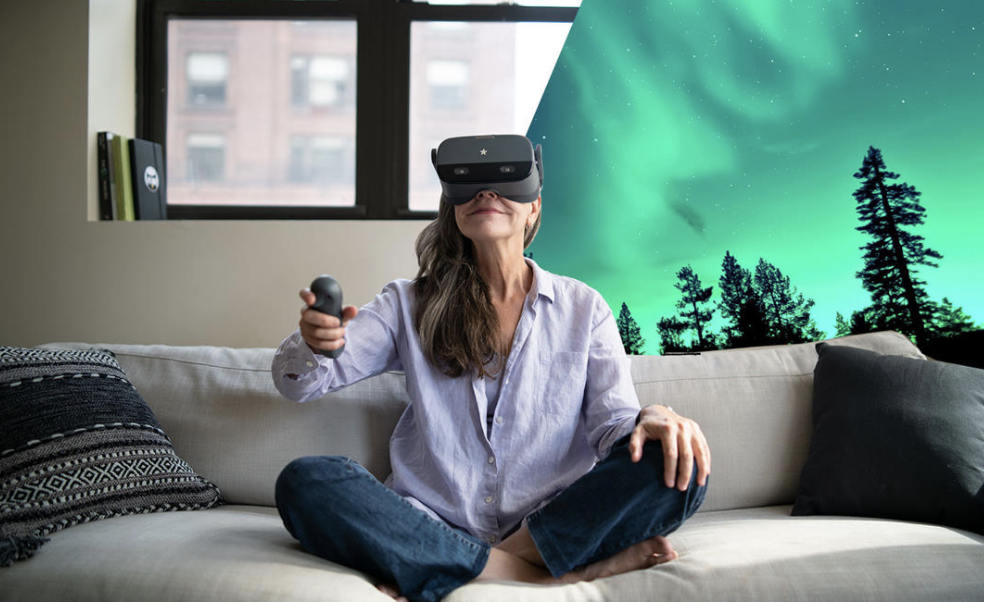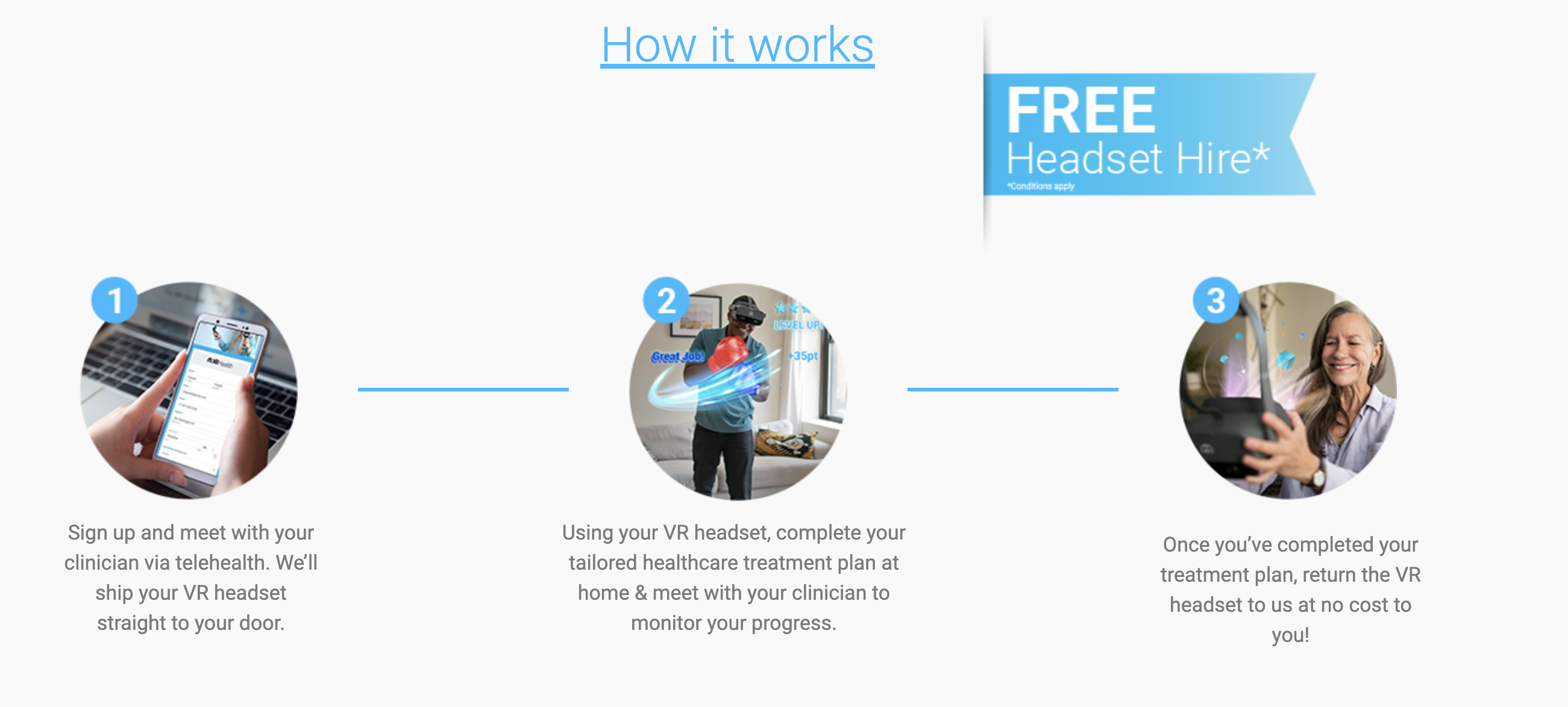
Virtual Reality (VR) is becoming more prominent in the medical world and it has finally landed as part of mainstream allied health treatments.
Studies to date have already demonstrated its effectiveness with various conditions and populations including children with acquired brain injuries, stroke patients, those with chronic pain. Anxiety and lower back pain. [2][3][4][5]
One of the main reasons VR is an effective treatment modality is improving patient engagement in their therapy. Gamifying therapy is a key feature in patients interacting more, doing their exercises more proactively and achieving great health outcomes.
To gamify therapy means to bring some elements from games, like skill progression and rewards, into the real-world therapy. A strong immersive experience can stimulate the patient and accomplish the same objective as conventional therapy, but with a simpler approach.
If you’re interested in trying virtual physiotherapy, no matter your age, book an appointment with XRHealth .
How VR Is Impacting the Medical World
Improving engagement and patient outcomes is critical in progressing a patient and gaining consistent results. Improving outcomes included reducing barriers such as access to feedback on performance, providing engaging therapy, treating physical, mental and cognitive wellbeing, addressing motivation to exercise and providing platforms that meet game-like training environments.
One study [6], described conditions for addressing these factors including having applications highlight:
- Skill level
- Goal orientated tasks
- Focus on the activity
- Level of concentration required
- Ability to “merg[e]… action and awareness”
- Loss of awareness of themselves in an experience
- Control over the activity they need to immerse themselves into
- Distortion of a temporal experience
Another study performed by the School of Rehabilitation Sciences at the University of Ottawa shows the amazing results that may be achieved by integrating VR into physical therapy:
- 71% of patients with traumatic brain injury showed a clinically significant improvement on the Community Balance and Mobility Scale (CB&M). Only 40% of patients showed improvement following the traditional therapy.
- Patients with Parkinson’s disease akinesia that use VR can initiate and sustain walking.
- Patients with hemiplegia following a stroke showed significant improvement in gait speed, leg muscle activity, increased symmetry during gait and improvement in overall quality of life.
- Post-stroke rehabilitation patients improved significantly more on reach velocity and reach duration on upper extremities compared with patients taking a conventional therapy.
- Decreased anxiety and reductions in self-report of pain from patients in post-operative therapy.
- Patients reported enjoyment and wanted to repeat the experience if possible [1]
Improving engagement and patient outcomes is critical in progressing a patient and gaining consistent results. XRHealth has enabled multifactorial reductions in barriers for patients to achieve greater outcomes with their therapeutically designed applications. With the increased expansion of VR and telehealth technology hopefully more patients will have increased accessibility to allied health and health outcomes right from their home.
If you’re interested in trying virtual physiotherapy, no matter your age, book an appointment with XRHealth . If the consulting Physiotherapist thinks you are a good fit for VR physiotherapy, you will be sent a VR headset to be used during your therapy and have a first session with a remote physiotherapist scheduled.
The XRHealth Platform
XRHealth, is the first global FDA and TGA registered VR medical device with applications available for a wide range of rehabilitation conditions and they are the only VR physiotherapy company to offer their services Australia wide. The platform includes applications that focus on improving upper extremity conditions including shoulder pathologies, neck pathologies, osteoarthritis of the spine and chronic pain. Applications developed also target hot flashes, mindset, anxiety, cognition and features modifiable for those with adhd and autism.
Biofeedback incorporated in these applications allow clinicians to develop specific care plans and parameters to tailor the exercise/therapy tools. The data provided allows for engagement and functional measures to be assessed, and utilized to predict improvement or decline. Some of the major outcomes assessed with the technology include; engagement, movement quality, trajectory of movement, reaction time and range of motion.

Book an appointment with XRHealth and try virtual physiotherapy from the comfort on your home
Virtual Reality and Aged Care
VR may sound like a young person’s technology but that is far from the truth. VR serves as a near perfect platform for the treatment and management of a number of age-related health conditions.
Our bodies naturally go through many changes as we age,such as a reduction in physical strength, coordination and bone density, stiffening joints and other movement issues. Many of these changes may affect a person’s mobility, balance and make them more likely to fall and possibly break a bone.
Other elements of an elderly person’s health may also be affected, such as an increased risk of diabetes, heart conditions, stroke, arthritis and lung disease as well as related negative impacts on mental health. All of this can reduce quality of life and make independent living all but impossible.
Physiotherapy can help to reduce these effects and has been shown to improve strength, balance, coordination, flexibility and decrease pain, but due to limited mobility issues, normal physiotherapeutic exercises may be difficult if not impossible. That’s where VR plays a vital role - gentle exercises that can be approached at the user’s own pace in their own environment, monitored remotely by qualified professionals to ensure therapy is painless and effective.
The ultimate goal is to help older adults maintain their function, well-being and independence.
Virtual physiotherapy now in Australia. Book your appointment with XRHealth now! No matter your age
How XRHealth Uses VR
Virtual Reality is a computer generated environment that users can interact with. Being able to utilise VR from the comfort of your home helps create a safe environment for exercise, making it easier to approach and maintain. XRHealth has created multiple applications that focus on strengthening various parts of the body and may also help reduce chronic pain, help treat anxiety, improve memory and mindfulness, and more.
Using VR applications allows physiotherapists to make rehabilitation as well as exercises to prevent injury fun and interactive. Gone are the days of a sheet of stick figures, using therabands and weights - instructions are given visually in the individual exercises, and motion tracking shows both the patient and physiotherapist are performing the exercises correctly.
Try virtual reality physiotherapy today. Book your online appointment - click here
A Strong Body and Mind
Everyone has heard the saying, “you can’t teach an old dog new tricks”. XRHealth wholeheartedly disagrees. As we grow older most, if not all of us still love to learn and experience new things. This allows the brain to continually be utilised and form new pathways.
XRHealth has many applications that are aimed at improving memory, cognitive function and promoting mindfulness. It also offers a library of different VR experiences so users can climb a mountain or traverse the countryside from home, no matter their level of mobility.
Sources:
[1] Li, A., Montatño, Z., Chen, V.J., Gold, J.I. 2011. Virtual Reality and Pain Management: Current Trends and Future Directions. Retrieved on July, 2019. From NCBI.
[2]. Levac, D., Miller, P., & Missiuna, C. (2012). Usual and virtual reality video game-based physiotherapy for children and youth with acquired brain injuries. Physical & occupational therapy in pediatrics, 32(2), 180-195.
[3]. Morris, L. D., Louw, Q. A., & Crous, L. C. (2010). Feasibility and potential effect of a low-cost virtual reality system on reducing pain and anxiety in adult burn injury patients during physiotherapy in a developing country. Burns, 36(5), 659-664.
[4]. Singh, D. K. A., Nordin, N. A. M., Abd Aziz, N. A., Lim, B. K., & Soh, L. C. (2013). Effects of substituting a portion of standard physiotherapy time with virtual reality games among community-dwelling stroke survivors. BMC neurology, 13(1), 1-7.
[5] Yelvar, G. D. Y., Çırak, Y., Dalkılınç, M., Demir, Y. P., Guner, Z., & Boydak, A. (2017). Is physiotherapy integrated virtual walking effective on pain, function, and kinesiophobia in patients with non-specific low-back pain? Randomised controlled trial. European Spine Journal, 26(2), 538-545.
[6] Zimmerli, L., Jacky, M., Lünenburger, L., Riener, R., & Bolliger, M. (2013). Increasing patient engagement during virtual reality-based motor rehabilitation. Archives of physical medicine and rehabilitation, 94(9), 1737-1746.